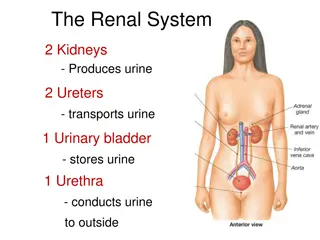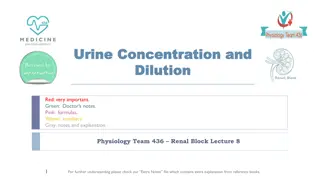Understanding Maple Syrup Urine Disease and Albinism
Maple Syrup Urine Disease (MSUD) is a metabolic disorder affecting the breakdown of branched-chain amino acids, leading to severe symptoms like physical and mental retardation, sweet-smelling urine, and metabolic acidosis. Treatment involves dietary restrictions and potential gene therapy. Albinism, on the other hand, results in a lack of melanin production, making individuals sensitive to sunlight but with normal eyesight and no neurological deficits.
Download Presentation

Please find below an Image/Link to download the presentation.
The content on the website is provided AS IS for your information and personal use only. It may not be sold, licensed, or shared on other websites without obtaining consent from the author. Download presentation by click this link. If you encounter any issues during the download, it is possible that the publisher has removed the file from their server.
E N D
Presentation Transcript
P.G. Diseases of amino acid metabolism- II VBC-607 Unit-1 6.11.2020
MAPLE SYRUP URINE DISEASE Also known as Branched chain ketonuria Partial or complete deficiency of branched-chain keto acid dehydrogenase (a multienzyme complex associated with inner membrane of mitochondrion) The enzyme complex that decarboxylate Leucine, Isoleucine and Valine Accumulation of-keto acids and hydroxy acids (especially leucine ) in blood and urine Physical and mental retardation of newborn Distinct maple syrup or burnt sugar odour in urine, breath and skin
BCAT: Branched chain aminotransferase BCKDH: branched chain keto acid dehydrogenase IVD: iso valeric acid dehydrogenase SBCAD: Short/branched chain acyl- CoA dehydrogenase IBDH: Isobutyric acid dehydrogenase
Branched chain AA and their metabolic products (- keto acids) accumulate in the blood, CSF Leads to toxic effect that interferes with neurologic changes and brain functions, including seizures and mental retardation
Symptoms Loss of appetite Fussiness Sweet-smelling urine Feeding problems Vomiting Dehydration Severe metabolic acidocis Physical disabilities and even death
Treatment Treatment involved dietary restriction of the amino acids leucine, isoleucine, and valine Supplementation of high doses of thiamine pyrophosphate Patients can be treated with I/v infusion that helps the body use up excess leucine, isoleucine, and valine for protein synthesis. Gene therapy is also a potential future treatment for patients with MSUD. This treatment would involve replacing the mutated gene with a good copy, allowing the patient's cells to make a functional BCKD protein complex and break down the excess amino acids
ALBINISM A group of inherited disorders that results in little or no production of the pigment melanin Lack of tyrosinase A marked lack of pigmentation Sensitive to damage from sunlight and must take added precaution against UV radiation Normal eyesight No neurologic deficits
Tyrosine hydroxylase and aromatic amino acid decarboxylase deficiencies: Inherited causes of impaired biogenic amine metabolism
Two main types of albinism - characterized by the areas affected by the abnormality: 1. Oculotaneous albinism and 2. Ocular albinism. 1. Oculotaneous albinism describes a phenotype that lacks pigment in the skin, hair, and eyes. 2. Ocular albinism occurs when the phenotype only lacks pigment from the eyes, the hair and skin appear normal in these individuals. Among the two types, oculotaneous albinism is typically more prominent
Methyl Malonic Aciduria A classical type of organic acidemia Condition is the inability to properly digest specific fats and proteins Leads to a buildup of a toxic level of methylmalonic acid in the blood An autosomal recessive disorder of amino acid metabolism, involving a defect in the conversion of methylmalonyl- coenzyme A (CoA) to succinyl-CoA
Symptoms Treatment Neurologic manifestations, such as seizure, encephalopathy, and stroke Several cases have involved stroke Protein-restricted diet- decreases the key amino acids (eg, isoleucine, valine, threonine, methionine) Cobalamin supplementation- a cofactor in the enzymatic conversion of methylmalonyl-coenzyme A (CoA) to succinyl-CoA. L-carnitine- involved in the metabolism of long-chain fatty acids, buffers the acyl- CoA metabolites Liver transplantation alone or in conjunction with kidney transplantation has been attempted
Homocystinuria disorder of the metabolism of the amino acid methionine Due to the defect in the enzyme Cystathionine synthase which converts Homocysteine to Cystathionine Leads to accumulation of homocysteine and other toxins that damage the nervous system, which includes the brain, and the vascular system
Symptoms dislocation of the lenses in the eyes nearsightedness abnormal blood clots osteoporosis, or weakening of the bones learning disabilities chest deformities, such as a protrusion or a caved-in appearance of the breastbone long, spindly arms and legs scoliosis
Treatment High doses of vitamin pyridoxine A diet low in the amino acid methionine (sulphur containing amino acid) Betaine is a nutrient that works to remove homocysteine from the blood. Taking a folic acid supplement and adding the amino acid cysteine to the diet are helpful
Hartnups disease Also known as Pellagra-like dermatosis Absorption of nonpolar amino acids (particularly tryptophan) intestine& kidney is impaired
Symptoms Treatment sensitivity to light anxiety hallucinations delusions tremor abnormalities in muscle tone: either muscles can become more tight consists of a change in diet, avoidance of sunlight, and prescribing sulfonamide drugs B-complex vitamin Niacin can significantly reduce symptoms. Good sources of niacin include: Meat, poultry, fish, fortified and whole grains B-complex or niacin vitamin supplements (such as nicatonic acid)























